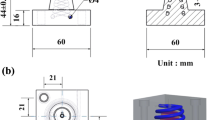Abstract
This paper presents an application of additive manufacturing (AM) technology that is suitable for manufacturing injection molding tools with conformal cooling channels to increase productivity. The design and the manufacturing of a hybrid injection molding insert by combining machining and selective laser melting (SLM) technologies was analyzed. A simplified finite element cooling analysis was used to compare conventional and hybrid solutions for the design of cooling channels to decrease the injection cycle time of an automotive plastic part. The simulation results showed that, by using a hybrid steel/high-conductivity copper alloy with conventional cooling for the design of the mold insert, the injection cycle time can be reduced by 50.3%, and by using hybrid steel/steel with conformal cooling, the injection cycle time can be reduced by 65.6%. The hybrid injection molding insert with conformal cooling made by selective laser melting (SLM) technology was successfully tested under real production conditions confirming the significant reduction of the injection cycle time.













Similar content being viewed by others
References
Phull GS, Kumar S, Walia RS (2018) Conformal cooling for molds produced by additive manufacturing: a review. International Journal of Mechanical Engineering and Technology 9(1):1162–1172
Au KM, Yu KM, Chiu WK (2011) Visibility-based conformal cooling channel generation for rapid tooling. Comput Aided Des 43(4):356–373
Xu RX, Emanuel S (2009) Rapid thermal cycling with low thermal inertia tools. Polym Eng Sci 49:305–316
Park HS, Pham NH (2009) Design of conformal cooling channels for an automotive part. Int J Automot Technol 10:87–93
Shayfull Z, Sharif S, Zain AM, Ghazali MF, Mohd Saad R (2014) Potential of conformal cooling channels in rapid heat cycle molding: a review. Adv Polym Technol 33(1):1–24. https://doi.org/10.1002/adv.21381
Wang Y, Yu KM, Wang CCL (2015) Spiral and conformal cooling in plastic injection molding. Computer Aided Des 63:1–11
Marques S, Souza AF, Miranda J, Yadroitsau I (2015) Design of conformal cooling for plastic injection moulding by heat transfer simulation. Polímeros 25(6):564–574. https://doi.org/10.1590/0104-1428.2047
Marin F, de Miranda JR, de Souza AF (2018) Study of the design of cooling channels for polymers injection molds. Polym Eng Sci 58(4):553–559
Kuo CC, Xu WC (2018) Effects of different cooling channels on the cooling efficiency in the wax injection molding process. Int J Adv Manuf Technol 98:887–895. https://doi.org/10.1007/s00170-018-2345-7
Dang XP, Park HS (2011) Design of U-shape milled groove conformal cooling channels for plastic injection mold. Int J Precis Eng Manuf 12(1):73–84
Mazur M, Brincat P, Leary M, Brandt M (2017) Numerical and experimental evaluation of a conformally cooled H13 steel injection mould manufactured with selective laser melting. Int J Adv Manuf Technol 93(1–4):881–900
Armillotta A, Baraggi R, Fasoli S (2014) SLM tooling for die casting with conformal cooling channels. Int J Adv Manuf Technol 71:573–583
Homar D, Čerče L, Kopač J (2017) Cooling simulation of conformal cooling injection mould insert produced by hybrid manufacturing. Tehnički vjesnik 24:981–986. https://doi.org/10.17559/TV-20150909075338
Yamazaki T (2016) Development of a hybrid multi-tasking machine tool: integration of additive manufacturing technology with CNC machining. Procedia CIRP 42:81–86. https://doi.org/10.1016/j.procir.2016.02.193
Rao NS, Schumacher G, Schott NR, O’Brien KT (2002) Optimization of cooling systems in injection molds by an easily applicable analytical model. J Reinf Plast Compos 21:451–459
Ozisik MN (1985) Heat transfer: a basic approach. McGraw-Hill Book Company, New York
Colburn AP (1933) A method of correlating forced convection heat transfer data and a comparison with fluid friction. Trans AIChE 29:174–210
Funding
The QUICKMOLD project has been funded by the European Regional Development Fund (ERDF). This support is gratefully acknowledged.
Author information
Authors and Affiliations
Corresponding author
Additional information
Publisher’s note
Springer Nature remains neutral with regard to jurisdictional claims in published maps and institutional affiliations.
Rights and permissions
About this article
Cite this article
Abbès, B., Abbès, F., Abdessalam, H. et al. Finite element cooling simulations of conformal cooling hybrid injection molding tools manufactured by selective laser melting. Int J Adv Manuf Technol 103, 2515–2522 (2019). https://doi.org/10.1007/s00170-019-03721-2
Received:
Accepted:
Published:
Issue Date:
DOI: https://doi.org/10.1007/s00170-019-03721-2




